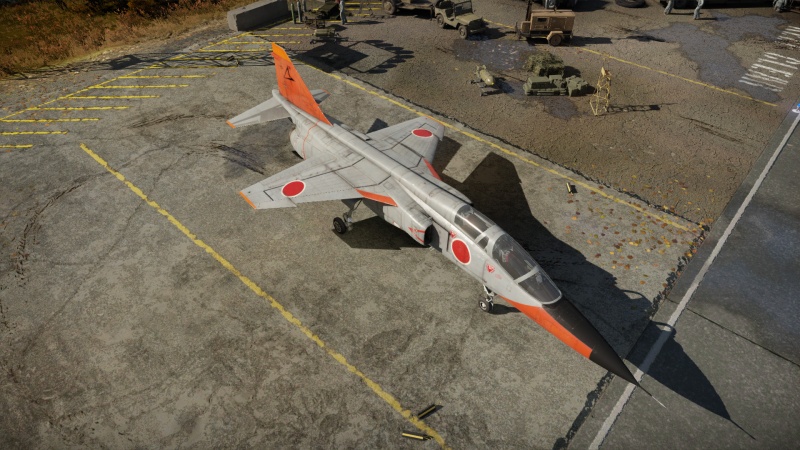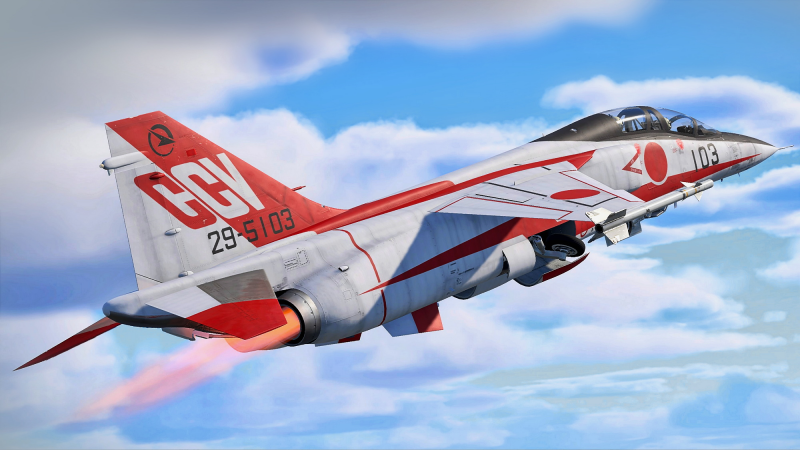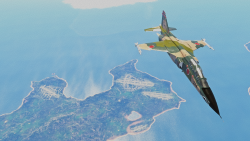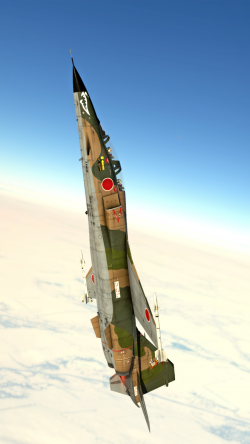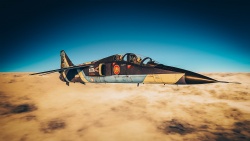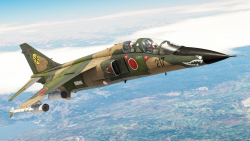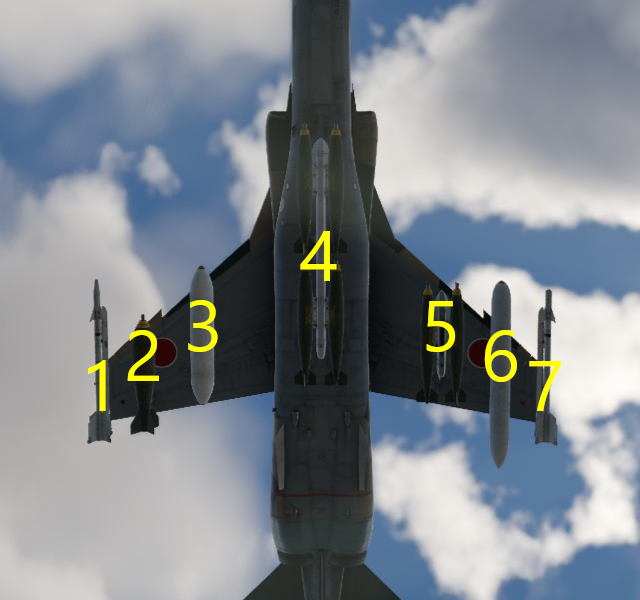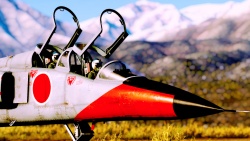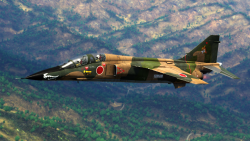Difference between revisions of "T-2"
(→Usage in battles) (Tag: Visual edit) |
(→Usage in battles) (Tag: Visual edit) |
||
| Line 198: | Line 198: | ||
== Usage in battles == | == Usage in battles == | ||
| − | + | The T-2 is a fast aircraft with very short wings, which makes it less effective at turning. A good tactic is to use "Boom and Zoom," which involves climbing to a high altitude and then diving down on enemies. After the attack, it’s important to maintain full speed while flying away to avoid enemy fire. However, be cautious of missiles; the T-2 doesn’t have flares or chaff, so it’s essential to be selective about which enemy aircraft to dive on. | |
[[File:T-2 YMSK 001.jpg|250px|thumb|right|{{PAGENAME}} taxiing for take-off.]] | [[File:T-2 YMSK 001.jpg|250px|thumb|right|{{PAGENAME}} taxiing for take-off.]] | ||
Latest revision as of 12:56, 26 October 2024
| This page is about the Japanese jet fighter T-2. For other variants, see F-1 (Family). |
Contents
Description
Throughout the late '60s, the JASDF came to note that their Fuji T-1 subsonic light trainer failed miserably at preparing pilots for the mach 2+ heavy frontline fighters currently in use with the JASDF, such as the F-104J and the F-4EJ Phantom II. At first, Japan considered acquiring foreign aircraft, but that idea quickly died down as the USA only offered the T-38 Talon and SEPECAT started asking for exorbitant licensing fees for their Jaguar. Realizing that foreign trainers were out of the question, a new set of development programs were started to develop new indigenous supersonic jets for Japan: First, the T-X program to field a supersonic trainer aircraft, and later the SF-X program stemming from it, to develop a single-seat attack aircraft on the basis of the T-X aircraft. Development of both aircraft was handed to Mitsubishi Heavy Industries after a fierce design proposal competition from Mitsubishi, Kawasaki, and Fuji. The first prototype of the new trainer "T-2" rolled off the production line on April 28, 1971, and conducted many static and ground tests before performing its first flight on July 20th of that year. After testing came to an end, production was authorized, and 90 T-2s were built, divided across 28 "T-2(Z)s", or "Zenkigata (early type)" and 62 "T-2(K)s", or "Kokigata (late type)". The aforementioned SF-X program to develop a strike aircraft based on the T-X would result in the F-1.
The Mitsubishi T-2, introduced in Update 1.87 "Locked On", is the first indigenous Japanese supersonic jet aircraft. It serves as a stepping stone from the subsonic rank 5 jets to the world of heavy supersonics at rank 6 and after. The T-2 has above-average speed and handling characteristics for its tier, along with decent missiles, however the biggest downside is the lack of any countermeasures, making the T-2 in the hands of less experienced pilots easy prey for the powerful all-aspect missiles at its tier such as the AIM-9L and the R-60M. Pilots flying the T-2 must exercise caution, maintain good situational awareness, and pick their engagements correctly to avoid taking a 30G missile to the face when they least expect it. Players who enjoy the T-2 should look forward to the F-1, a direct development of the aircraft, turning the trainer T-2 into a fully fledged single-seat strike fighter.
General info
Flight performance
The T-2 was designed and built for one main purpose, and that was to train pilots in flight at around Mach 1.4 in preparation for flying faster Mach 2+ fighters such as the F-4EJ, F-104, and the Mitsubishi F-1. With a long narrow body, short main wings without fuel tanks and an all-moving tailplane, this aircraft was built streamlined like the F-104 to get you from point A to point B in the shortest amount of time possible and not spend too much time manoeuvring. While excelling as an interceptor, this fighter will still hold its own in a manoeuvring fight, granted as long as under-wing armaments are limited to the Sidewinder missiles and not the heavy bombs.
The sleekness of the aircraft lends itself to flying fast, and speed should be maintained when flying, especially during air-to-air combat, as a slow-flying T-2 is a relatively easy target due to poor manoeuvrability at slow speeds. To help in instances where the aircraft must fly at slower speeds (landing, bombing and ground rocket attack), slats and spoilers help create a higher lift capacity and roll rate, preventing the aircraft from stalling and plummeting.
Air-to-air combat should be avoided when carrying bomb loads, as this will significantly decrease manoeuvrability. During a ground attack, all efforts should be made to get to the target as soon as possible and release the heavy ordnance and then proceed to any aerial combat in the near vicinity.
Damage to the aircraft, especially to the wings, will typically result in the destruction of the aircraft. Due to their relatively small size, any loss in surface area will cause the fighter to over-lift on the good side, sending the aircraft into a roll and then potentially into a flat spin.
| Characteristics | Max Speed (km/h at 10,975 m) |
Max altitude (metres) |
Turn time (seconds) |
Rate of climb (metres/second) |
Take-off run (metres) | |||
|---|---|---|---|---|---|---|---|---|
| AB | RB | AB | RB | AB | RB | |||
| Stock | 1,679 | 1,664 | 15200 | 33.6 | 34.9 | 119.4 | 109.2 | 900 |
| Upgraded | 1,753 | 1,710 | 32.4 | 33.0 | 162.5 | 140.0 | ||
Details
| Features | |||||
|---|---|---|---|---|---|
| Combat flaps | Take-off flaps | Landing flaps | Air brakes | Arrestor gear | Drogue chute |
| ✓ | ✓ | ✓ | ✓ | ✓ | ✓ |
| Limits | ||||||
|---|---|---|---|---|---|---|
| Wings (km/h) | Gear (km/h) | Flaps (km/h) | Max Static G | |||
| Combat | Take-off | Landing | + | - | ||
| 1,365 | 485 | 735 | 525 | 450 | ~10 | ~4 |
| Optimal velocities (km/h) | |||
|---|---|---|---|
| Ailerons | Rudder | Elevators | Radiator |
| < 650 | < 580 | < 650 | N/A |
Engine performance
| Engine | Aircraft mass | |||||||
|---|---|---|---|---|---|---|---|---|
| Engine name | Number | Basic mass | Wing loading (full fuel) | |||||
| Ishikawa-Harima TF40-801A | 2 | 6,584 kg | 452 kg/m2 | |||||
| Engine characteristics | Mass with fuel (no weapons load) | Max Takeoff Weight | ||||||
| Weight (each) | Type | 17m fuel | 20m fuel | 30m fuel | 45m fuel | 56m fuel | ||
| 810 kg | Afterburning low-bypass turbofan | 7,479 kg | 7,635 kg | 8,161 kg | 8,949 kg | 9,566 kg | 13,500 kg | |
| Maximum engine thrust @ 0 m (RB/SB) | Thrust to weight ratio @ 0 m (WEP) | |||||||
| Condition | 100% | WEP | 17m fuel | 20m fuel | 30m fuel | 45m fuel | 56m fuel | MTOW |
| Stationary | 1,950 kgf | 3,105 kgf | 0.83 | 0.81 | 0.76 | 0.69 | 0.65 | 0.46 |
| Optimal | 2,010 kgf (200 - 400 km/h) |
3,437 kgf (1,000 km/h) |
0.92 | 0.90 | 0.84 | 0.77 | 0.72 | 0.51 |
Survivability and armour
- 38 mm bulletproof glass - situated between the fore and aft cockpits
The T-2 fighter, like many more modern aircraft, have shed most of its armour instead of more speed and agility. The only armour outfitted on this aircraft is the 38 mm bulletproof glass situated between the fore and aft cockpit, giving the rear pilot a pretty good chance of surviving an impact or bullet strike which might take out the front pilot. Beyond that, the aircraft's survivability is a mix of engineering and the pilot's skill. Damage sustained to the wings will not affect fuel loss as no tanks are mounted here; they are only mounted within the aircraft's fuselage. While many aircraft can absorb a huge amount of ammunition rounds in the fuselage before losing something important when it comes to the T-2 fuselage hits typically result in a hit to the engines, oil coolers, fuel, pilots or the radar. This is where pilot skill and manoeuvring come into play to make it very difficult for an enemy pilot to get a firing solution. High-G manoeuvres within this aircraft may hurt the speed and manoeuvrability; however, it may save the pilot's lives by causing many missiles such as the AIM Sidewinders to miss due to their lower g-turn threshold.
Modifications and economy
Armaments
Offensive armament
The T-2 is armed with:
- 1 x 20 mm JM61A1 cannon, chin-mounted (750 rpg)
The JM61A1 20 mm Vulcan cannon is a monster and, at the same time, a headache for new pilots not used to it. Unlike most other machine guns and cannons in the game (or in real life, for that matter), trigger depression here does not immediately produce flying bullets. Due to the characteristics of the JM61A1 cannon, it requires an initial spool-up time or spin of the cannon barrels before ammunition can be fired. The high rate of fire can easily melt the barrel, however with the rotating barrels, each barrel can cool off enough before it is its turn again to prevent damage. To initiate this, trigger depression will result in a .25 second delay before the ammunition begins to fire to allow for the barrels to get to proper rotating speed. Once it gets going, 750 rounds of ammunition do not last very long.
When targeting an aircraft, for example, the pilot must remember this formula to be successful while leading an aircraft or before an aircraft passes through the crosshairs, start squeezing the trigger about .5 to .25 seconds before that event, and the cannon rounds should land on target. Waiting until a target passes through the crosshairs (unless tailing them) will result in a miss as they will be out of the sights before the cannon starts firing.
Trigger discipline is necessary when using this cannon as due to its rate of fire (about 6,000 RPM, ~100 RPS or 7.5 seconds of ammunition) will easily blow through the 750 rounds carried by the T-2.
Suspended armament
The T-2 can be outfitted with the following ordnance:
| 1 | 2 | 3 | 4 | 5 | 6 | 7 | ||
|---|---|---|---|---|---|---|---|---|
| 500 lb LDGP Mk 82 bombs | 1 | 1 | 1 | 1 | 1 | |||
| 750 lb JM117 cone 45 bombs | 1 | 1 | 1 | 1 | 1 | |||
| FFAR Mighty Mouse rockets | 19 | 19 | 19 | 19 | ||||
| Zuni Mk32 Mod 0 ATAP rockets | 4 | 4 | 4 | 4 | ||||
| AIM-9B Sidewinder missiles | 1 | 1 | ||||||
| AIM-9E Sidewinder missiles | 1 | 1 | ||||||
| AIM-9P Sidewinder missiles | 1 | 1 |
| Default weapon presets | |
|---|---|
| |
Usage in battles
The T-2 is a fast aircraft with very short wings, which makes it less effective at turning. A good tactic is to use "Boom and Zoom," which involves climbing to a high altitude and then diving down on enemies. After the attack, it’s important to maintain full speed while flying away to avoid enemy fire. However, be cautious of missiles; the T-2 doesn’t have flares or chaff, so it’s essential to be selective about which enemy aircraft to dive on.
Pros and cons
Pros:
- Faster and better acceleration than many jets at its BR
- High climb rate
- 2 pilots (not as vulnerable to pilot snipes)
- Devastating JM61A1 rotary cannon with a decent ammo pool
- Variety of air-to-ground and multirole payloads
- Decent PD radar that can detect up to 60 km away, useful in large maps to find targets
- The high Angle-of-Attack in certain maneuvers can be very useful defensively and offensively
Cons:
- A lack of any Countermeasures make it an easy kill in its BR, where air-to-air missiles are common
- Poor energy retention, low-speed manoeuvrability and large turning radius make avoiding missiles and dogfighting extremely challenging if often impossible
- A lack of Ballistic Computer limits the use of the air-to-ground munitions
- The JM61A1 rotary cannon may take getting used to as it doesn't fire immediately but has a short spool up time before it starts firing
- Burns through fuel at an astronomical rate
- Both engines overheat at constant use with the afterburner
History
Soon after WW2, Japan was mostly offered jet fighter aircraft from the USAAF / USAF, such as the later versions of the F-86 Sabre, to protect itself from threats such as North Korea, which was at the time in conflict with the United States (in the 1950s). In the late '50s and '60s, Japan had already developed its first modern jet-aircraft, the Fuji T-1, which was mainly used as a trainer aircraft. But by the '70s, it was obsolete; Japan needed a new trainer aircraft, which could train pilots for near Mach 2 speeds.
During the time between 1964-1965, engineers at Mitsubishi began working on a project called "T-X", which would be either a 1 or 2 seater aircraft that would later be developed into another project for a ground attack aircraft called the "SF-X".
Simultaneously, the United States offered Japan the T-38, and Britain/France offered the SEPECAT Jaguar for investigation. Japan thought of a project of license-building these aircraft, which has later failed due to issues between SEPECAT and the Japanese Imperial Family.
In 1967, Japanese aircraft manufacturers Fuji, Kawasaki and Mitsubishi proposed their designs for the XT-2, of which Mitsubishi's design was accepted. The prototype (pre-production model) would be built in 1971, seeing its maiden flight on July 20 1971, flown by Dr. Kenji Ikeda.
The XT-2 became the first Japanese-built aircraft to break the sound barrier in level flight. It was put into final production later that year.
The variants of the final model, the T-2 were: T-2Z (early model that later ended up being modified for the SF-X program), T-2A and T-2B (trainer models) and the T-2K, the armed model, carrying a 20 mm M-61 Vulcan fast-firing autocannon. The aircraft was produced until 1988 and was retired in 2006 along with its fighter variant, the F-1 when it was replaced by its successor, the Kawasaki T-4 (the Mitsubishi F-2 Viper Zero replaced the F-1).
Media
- Skins
- Videos
See also
- Related development
- Aircraft of comparable role, configuration, and era
External links
- [Devblog] Mitsubishi T-2: The Supersonic Stork
- Official data sheet - more details about the performance
| Japan jet aircraft | |
|---|---|
| IJNAS | |
| Experimental | Kikka |
| Reconnaissance | R2Y2 Kai V1 · R2Y2 Kai V2 · R2Y2 Kai V3 |
| IJAAS | |
| Fighters | Ki-200 |
| JASDF | |
| Fighters | F-86F-30 ▅ · F-86F-40 ▅ · F-86F-40 JASDF▅ |
| F-104J | |
| F-4EJ Phantom II · F-4EJ ADTW · F-4EJ Kai Phantom II | |
| F-15J · F-15J(M) | |
| F-16AJ | |
| F-1 | |
| Trainers | T-2 Early · T-2 |
| Foreign | |
| Thailand | ▄AV-8S · ▄F-5E FCU |



